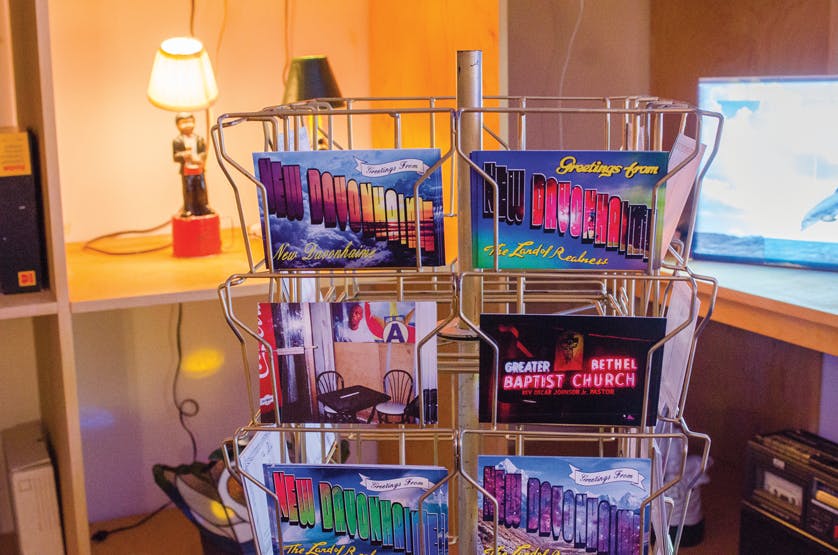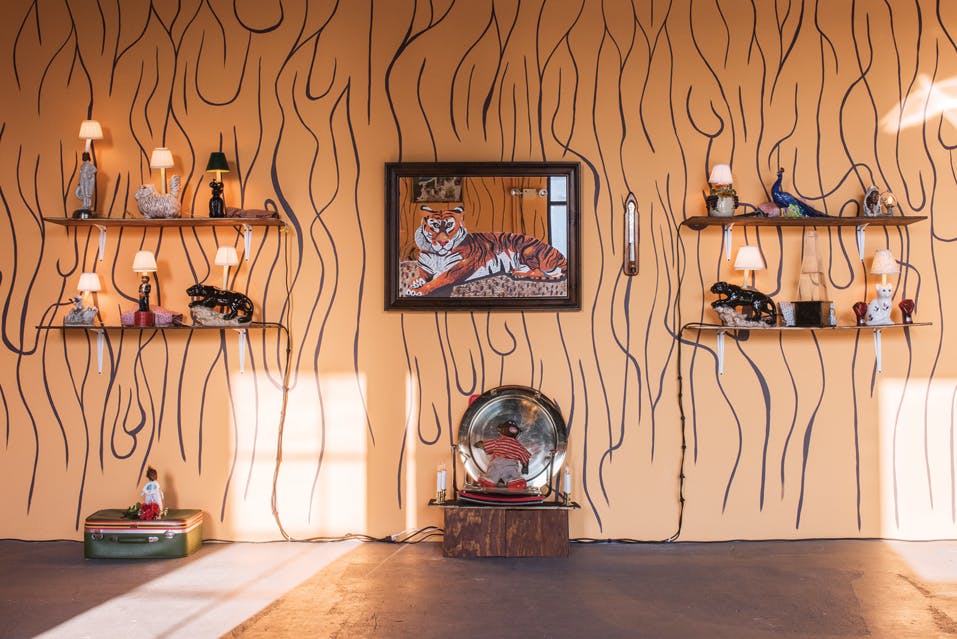Studio Visit: Greetings from New Davonhaime, Azikiwe Mohammed

Portrait from the St. Louis version of Armor Photo Studio, as presented by The Luminary for Counterpublic, 2019

Portrait from the St. Louis version of Armor Photo Studio, as presented by The Luminary for Counterpublic, 2019
Inscribed on a travel-size postcard, the words “Greetings from New Davonhaime” are written in a font akin to the large letter postcards popularized in the early twentieth century. Written in a different script are the words “The Land of Realness.” Combining the names of the five most densely populated Black cities across the country—New Orleans, Birmingham, Detroit, Jackson, and Savannah—a super-town is built. Like any new town, a certain system needs to be put in place for the community to function and thrive. On a case-by-case basis, Azikiwe Mohammed establishes these new businesses as pillars of the community: Jimmy’s Thrift, Armor Photo Studio, the New Davonhaime Food Bank. Adjacent to New Davonhaime, Leroy’s Luncheon offers real dining experiences meant to address two issues Black and brown people face— hunger and lack of care.
Still, Mohammed wanted to refrain from the idea of building a Black utopia. He says, “That’s a space where you put things too big to work on and too big to realize. Like, ‘I dream of the lottery.’ Right concepts, but it’s not a workable direction. Dreams are location non-dependent.” Utopia, by definition, is “an imagined place or state of things in which everything is perfect.” Towns like Allensworth, California, established by Allen Allensworth in 1908, offered respite to African Americans from the fraught realities of the Jim Crow era. The growing city was founded, financed, and governed by African Americans through the 1960s until the threat of contaminated water ended it. In the ongoing photography project “Allensworth,” artist and researcher Ariana Faye Allensworth, a direct descendent of Allen Allensworth, interweaves her own familial history, some archival materials, and the artwork of other contemporary artists to unearth and engage the city’s imagined history.
Through an object-based practice, Mohammed sought to form a similar location. The project is realized through a series of site-specific installations, one-off portrait sessions, and a functional food bank. Within an ever-changing set of configurations, visitors confront a range of Black material culture as points of entry and departure. In New Davonhaime, memories are measured through Mohammed’s investigation of place and space as guided by a variety of characters. These installations include everything from clothes, neon sculptures, tapestry, photography, paintings, and embroidery made by Mohammed, and the objects he collects.
Foundational to his practice, but particularly New Davonhaime, function and purpose intertwine, as Mohammed sorts through themes of worldbuilding and Black placemaking.


Recipe for ginger carrot soup, as found in Lunch with Leroy at Home, Vol. 1, 2023
Jimmy’s Thrift
Jimmy, performed by Mohammed, owns Jimmy’s Thrift of New Davonhaime. A performative installation, the thrift store is the starting point, much like a welcome center for visitors. The thrift store contains found and handmade materials. As Mohammed puts it, “objects are places for us to exercise memories out of our heads and lock them into a physical form, whereas what’s in your head is changing all the time.”
He examines this notion by leaning on non-bodied forms of blackness: nameplate necklaces, airbrushed T-shirts, afro picks, and the color purple. Many of these objects are intergenerational symbols and may unlock a forgotten memory. They are objects typically found in Black homes or specific to Black people—an ode to figuration, Mohammed reconfigures African American figurines into lamps adorned with lamp shades, very similar to the ones found atop grandma’s china cabinet. He almost proposes that Black people have come to interpret the world through a distinct set of objects and visual systems. There is a shared language, and it is so clear what it is.
Armor Photo Studio
In May of 2017, Armor Photo Studio was first staged at Long Gallery in Harlem. Mohammed invited people to pose and participate in a portrait session at no cost. Each sitter was gifted a five-by-seven print of their desired photograph. The sessions called to mind folks who flocked to sit for James Van Der Zee. (Over six decades, Van Der Zee chronicled the lives of Black people throughout the Harlem Renaissance and upheld a strong studio portrait practice until his death.) In one untitled photograph, a Black woman clad in a skin-tight, two-piece, body-con pant set stands in a contrapposto pose. Waves wash ashore on the sandy beach. With her mouth slightly agape, she licks her lips and rests her hand on her hips. She casts a flirtatious gaze directly at the camera. The second iteration took place in St. Louis as part of The Luminary’s civic exhibition, Counterpublic. As an extension of Armor Photo Studio’s month-long residence in St. Louis, the artist spent an entire day at a daycare facility offering portraits to whoever was interested or couldn’t make it to the main studio location. His father also photographed at schools and churches,1 and the studio takes its name after the photo company he founded.
New Davonhaime Food Bank and Leroy’s Luncheon


The New Davonhaime Food Bank is defined as “a non-location-based food bank serving a wide variety of communities and spaces through redirecting monies for the arts into monies for food.”2 Across the five boroughs, Mohammed has been able to “make all food to all the people a reality for as many as we can.”3 The food bank distributes approximately one hundred bags of food each time, with each containing three to five meals.
Not all of Mohammed’s attempts take place in other spaces; some, such as Leroy’s Luncheon, happen in real time. Leroy’s Luncheon is an immersive interaction with recipes that follow. The project manifests in three parts: a cookbook, a TV show, and Leroy’s Diner, the first version of which took place at Canada Gallery, with subsequent activations taking place in homes and art venues by preparing home-cooked meals. There is also a delivery service, which finds Leroy delivering food to those who can’t make it to the diner. The book, Lunch with Leroy at Home, vol. 1, is a collection of crowd-sourced recipes. Mohammed considers diners an “extension of someone’s living room.” ⁴ They are places that you can walk into and fall into normalcy, and, like Leroy’s, they function to fulfill a community need.
With New Davonhaime, the artist has developed a place from which anyone can depart, return to, and build upon, as needs change and communities learn to function differently. This project, like Mohammed, is committed to serving people in need. He says, “Art should be something you’re able to share together.” He has brought to life a space that knows, listens, and leans on its people to sustain this one place they call home.
Just in time for the holiday season, we’re sharing six, Life-Affirming Recipes via Azikiwe Mohammed sure to carry you into the new year.


Jimmy's thrift of New Davonhaime, presented by the Knockdown Center, 2017.
[1] Arden Fanning Andrews, “’You Can Build Spaces That Mirror the Safety You Wish You Had’: Meet Artist Azikiwe Mohammed, Who Designs Safe Havens for Black People,” Artnet.com, July 7, 2020.
[2] Azikiwe Mohammed, “New Davonhaime Food Bank,” azikiwephoto.com.
[3] “Azikiwe Mohammed in Conversation,” New Art Dealers, https://newartdealers.org/programs/ outside-and-with-place-azikiwe-mohammed-in-conversation.
[4] Azikiwe Mohammed interviewed by Jayson Overby Jr. Audio recording New York, August 18, 2023.